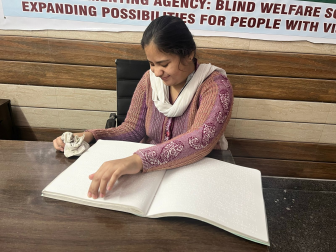Eating healthily on a budget can be a challenge for many, but it presents unique difficulties for visually impaired individuals who may encounter additional obstacles in meal planning and preparation. However, with the right strategies and resources, maintaining a nutritious diet while managing expenses is entirely feasible. This blog provides practical advice for visually impaired individuals to enjoy healthy, budget-friendly meals.
Visually impaired individuals may face specific challenges related to healthy eating on a budget:
Grocery Shopping: Identifying products, comparing prices, and reading labels can be difficult without visual assistance.
Meal Planning: Planning balanced meals that meet nutritional needs can be challenging without clear guidance and accessible recipes.
Cooking: Preparing meals safely and efficiently requires adapting cooking techniques and tools to ensure ease of use and safety.
Smart Grocery Shopping:
Use Assistive Technology: Utilize apps and devices designed for grocery shopping assistance. Apps like Be My Eyes or Aira provide real-time visual support through a smartphone camera, helping with product identification and label reading.
Stick to a List: Plan your meals for the week and create a shopping list to avoid impulse purchases and ensure you buy only what you need. Voice assistants or braille labels can help in creating and managing your list.
Buy in Bulk: Purchasing staple items like grains, beans, and canned goods in bulk can be more cost-effective. Look for stores with bulk buying options and take advantage of sales or discounts.
Affordable, Nutritious Foods:
Emphasize Whole Foods: Focus on whole, unprocessed foods such as vegetables, fruits, whole grains, and legumes. These are often more affordable and provide essential nutrients.
Seasonal Produce: Buy fruits and vegetables that are in season as they tend to be cheaper and fresher. Use accessible resources to determine what’s in season locally.
Frozen and Canned Options: Frozen and canned fruits and vegetables can be more affordable and have a longer shelf life. Opt for options without added sugars or sodium.
Effective Meal Planning:
Plan Balanced Meals: Include a variety of food groups in each meal—proteins, carbohydrates, and vegetables. Use meal planning apps or services that offer accessible formats to help create balanced meal plans.
Batch Cooking: Prepare meals in large quantities and freeze portions for future use. This can save time and money, ensuring you have healthy meals readily available.
Affordable Proteins: Incorporate budget-friendly protein sources such as beans, lentils, eggs, and canned tuna. These options are often less expensive than meat and provide essential nutrients.
Accessible Cooking Techniques:
Use Adapted Kitchen Tools: Invest in adaptive kitchen tools like talking kitchen scales, braille measuring cups, and tactile timers to make cooking easier and safer.
Simple Recipes: Opt for recipes with fewer ingredients and straightforward steps. Accessible recipe websites and apps can provide recipes in braille or audio formats.
Safe Cooking Practices: Ensure kitchen safety by using tools with non-slip handles and organizing your kitchen to minimize the risk of accidents.
Finding Support and Resources:
Community Programs: Explore local community programs and organizations that offer support for visually impaired individuals, including cooking classes, meal delivery services, and food assistance programs.
Online Resources: Utilize online resources providing accessible information on budgeting, meal planning, and cooking. Websites and forums dedicated to visually impaired individuals can offer valuable tips and support.
Eating healthily on a budget is an attainable goal for visually impaired individuals with the right strategies and resources. By leveraging assistive technologies, focusing on affordable and nutritious foods, planning meals effectively, and using adapted cooking tools, you can maintain a balanced diet without overspending.
Accessible grocery shopping, meal planning, and cooking are key to a healthy lifestyle. With determination and the right support, visually impaired individuals can enjoy nutritious, budget-friendly meals that enhance overall well-being. Embrace these tips and resources to make healthy eating a satisfying and sustainable part of your life.
By contributing to our feature donation campaigns, you are not just supporting us,
you are fostering independence, education, and accessibility for the people with blindness.
We are providing free shelter, food and educational support to the abandoned visually impaired girls residing at BWS.
₹1146562
raised of ₹2000000 Goal
57%
4 Days left
573 Supporters
Maa and Papa weren’t the happiest when I was born. They thought I was a burden to them.
₹769463
raised of ₹2000000 Goal
38%
4 Days left
590 Supporters
The Walking Canes have proved a useful tool to millions of blind people in navigating their environments with confidence and ease.
At our organization, we provide a nurturing environment for visually impaired girls, helping them lead fulfilling lives despite their challenges.
The following stories highlight the transformative journey of these remarkable individuals within our organization.

Hailing from Delhi, Sneha came to Blind Welfare Society in July 2023.
.jpeg)
Hailing from a small village of Gwalior district, Madhya Pradesh, Archana came to Blind Welfare Society in July 2023

Chhavi’s journey is a testament to the transformative power of education and the invaluable support provided by the Blind Welfare Society.